| |
|
|
19.
| I like America, tribute to Jacques Derrida |
| |

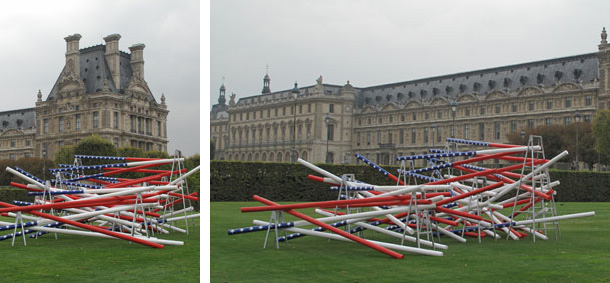
2007, 44 painted jumping poles, ladders in metal, size may vary.
Exhibition view of Tuileries, FIAC, 2010, Paris.
Courtesy of the artist and Wilde Gallery, Geneva.
Ed. of 5 + 1 A.P.
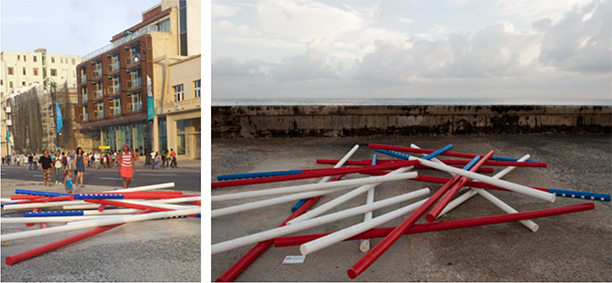
2007, 44 painted jumping poles, ladders in metal, size may vary.
Exhibition view of Detras del Muro, Collateral project 12th Havana Biennial, 2015, La Havane.
Courtesy of the artist and Wilde Gallery, Geneva.
Ed. of 5 + 1 A.P.
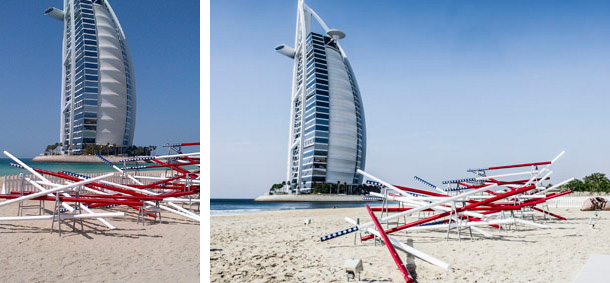
2007, 44 painted jumping poles, ladders in metal, size may vary.
Exhibition view of Sculpture on the Beach, Art Dubai, 2013, Dubai.
Courtesy of the artist and Wilde Gallery, Geneva.
Ed. of 5 + 1 A.P.
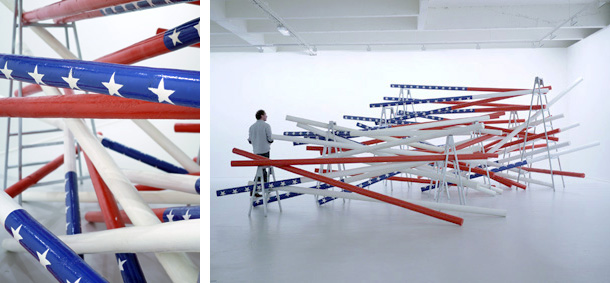
2007, 44 painted jumping poles, ladders in metal, size may vary.
Exhibition view of Collector, Lille3000, 2011, Lille.
Courtesy of the artist and Wilde Gallery, Geneva.
Ed. of 5 + 1 A.P.
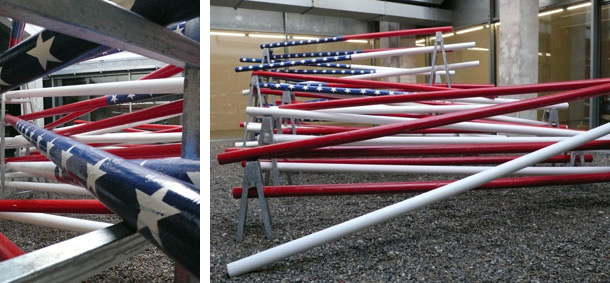
2007, 44 painted jumping poles, ladders in metal, size may vary.
Exhibition view of J'aime l'Amérique, La maison rouge, 2007, Paris.
Courtesy of the artist and Wilde Gallery, Geneva.
Ed. of 5 + 1 A.P.
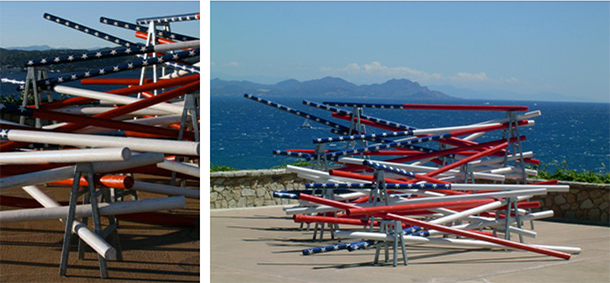
2007, 44 painted jumping poles, ladders in metal, size may vary.
Exhibition view of Dialogues méditerranéens, 2007, Saint Tropez.
Courtesy of the artist and Wilde Gallery, Geneva.
Ed. of 5 + 1 A.P.
 Video Video
'' The jumping poles, when they are painted in stars and stripes, they evoke Joseph Beuys’s performance as a stranger in a strange land.
This work, however, lacks Beuys’s self-assured rejoinder, “. . . and America likes me,” as if the matter is still up for question.
Whether America likes “me” is an immigrant’s question. ''
Naomi Beckwith, Flow, 2008
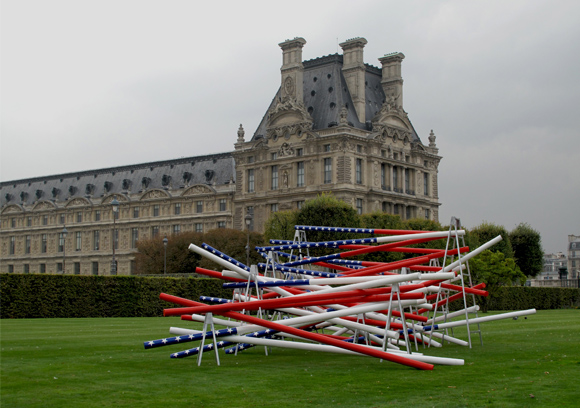
I like America, tribute to Jacques Derrida
Exhibition view of Tuileries, FIAC, 2010, Paris.
Courtesy of the artist.
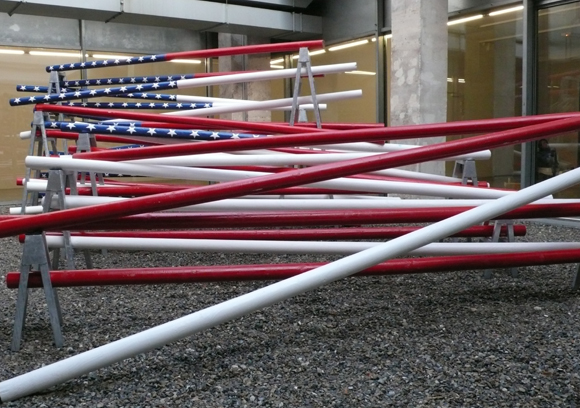
I like America, tribute to Jacques Derrida
Exhibition view of J'aime l'Amérique, La maison rouge, 2007, Paris.
Courtesy of the artist.
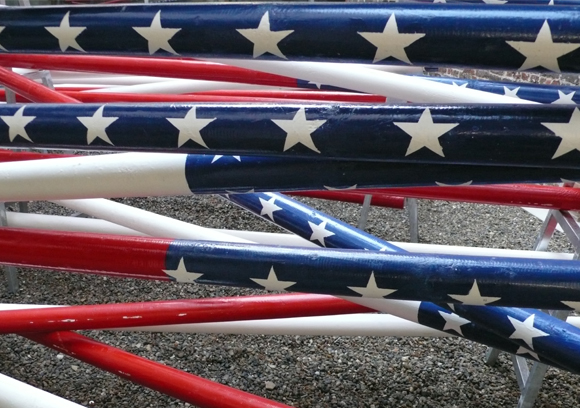
I like America, tribute to Jacques Derrida
Exhibition view of J'aime l'Amérique, La maison rouge, 2007, Paris.
Courtesy of the artist.
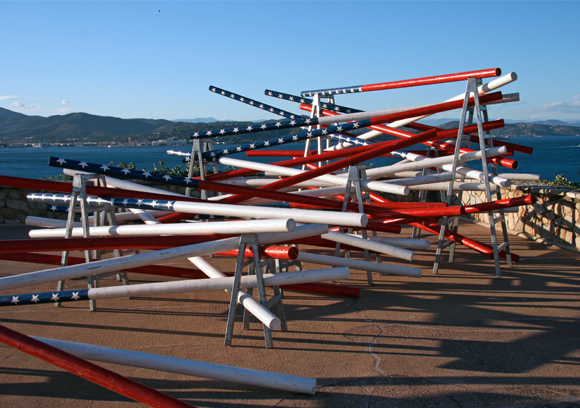
I like America, tribute to Jacques Derrida
Exhibition view of Dialogues méditerranéens, 2007, Saint Tropez.
Courtesy of the artist.
|
|
|
|
|
| Collection of FNAC, Fonds National d'Art Contemporain, Paris
Collection of Navarra, France
|
A l’aide de barres de saut hippique, repeintes aux couleurs de la bannière étoilée, mounir fatmi transforme le drapeau américain en un immense obstacle impossible à franchir. Cet amas complexe de barres rouges, blanches et bleu, tel un mikado géant, occupe l’espace du patio et se dresse comme une sculpture à la fois imposante, instable et dangereuse.
Ces obstacles reviennent comme un leitmotiv dans l’œuvre de l’artiste. Ils représentent à chaque fois un nouveau défi à relever. J’aime l’Amérique invite le spectateur à dépasser l’idée de drapeau, de territoire et d’identité, toutes ces limites qui s’imposent en permanence à l’artiste et à tous ceux qui cherchent à franchir des frontières.
Comment contourner ces murs qui jalonnent l’histoire des relations entre l’Amérique, l’Europe et le reste du monde, comme celui qui est en projet entre les Etats-Unis et le Mexique ? Inspiré par la déconstruction de Jacques Derrida, Mounir Fatmi relie pour défaire, défait pour lier et joue de la multiplicité des points de vue. Lorsqu’on le contourne, son obstacle géant présente des failles et l’image du drapeau se désagrège, miroir d’une Amérique aux multiples facettes.
J’aime l’Amérique est à la fois un hommage et une critique. Sur le plan formel elle rappelle l’architecture, le Pop Art, Jasper Johns et tout ce que l’Amérique aura apporté à l’histoire de l’art. Mais son titre renvoie à la fameuse action de Joseph Beuys en mai 1974 : I like America and America likes me. A son arrivée à New York, l’artiste allemand se fit enfermer pendant quatre jours dans une galerie avec un coyote, l’animal sacré des Indiens ; puis il repartit pour l’Allemagne sans avoir échangé une parole avec quiconque. Réalisée en pleine guerre du Vietnam, cette performance invitait à une réconciliation entre l’homme et la nature, entre l’oppresseur et l’opprimé. L’installation de mounir fatmi, en 2007, vient lui donner une nouvelle actualité.
*Cette performance a été réalisée à New-York du 21 au 25 mai 1974 à la galerie René Block. Joseph Beuys avait choisi un coyote parce que c’était l’animal emblématique des Indiens d’Amérique. Il voulait apprivoiser ce symbole d’un peuple exterminé au nom du progrès, et réconcilier nature et culture.
Studio Fatmi, Octobre 2007.
Avec le soutien de
Fundaciòn Almine y Bernard Ruiz-Picasso Para El Arte
|
|
Using equestrian jumping poles, painted in the colours of the star-spangled banner, mounir fatmi transforms the American flag into an immense impenetrable obstacle. This complex mass of red, white and blue poles, like a giant spillikins, towers like a sculpture that is both imposing, unstable and dangerous.
These obstacles recur like a leitmotif in the artist's work. Each time they represent a new challenge to be taken up. I like America invites the spectator to go beyond the idea of the flag, territory and identity – limits that are constantly imposed on the artist and anyone trying to overcome boundaries.
How can we get around these walls, that punctuate the history of relations between America, Europe and the rest of the world, like the one that is being planned between the United States and Mexico? Inspired by Jacques Derrida's deconstruction, mounir fatmi makes connections that disassemble and dismantles things in order to create links, playing on various perspectives. As you go around it, the giant obstacle reveals rifts and the image of the flag breaks up, like a mirror of a multi-faceted America.
I like America is both a tribute and a criticism. Formally it is reminiscent of architecture, Pop Art, Jasper Johns and everything that America has brought to the history of art. But the title refers to Joseph Beuys' famous performance in May 1974: I like America and America likes me. When he arrived in New York, the German artist locked himself up in a gallery for four days with a coyote, the sacred animal of Native Americans. He then returned to Germany without having spoken to anyone. This performance, which took place in the midst of the Vietnam war, suggested a reconciliation between man and nature, between the oppressor and the oppressed.
With the support of the Fundaciòn Almine y Bernard Ruiz-Picasso Para El Arte
Studio Fatmi, Octobre 2007.
|
|
|
|